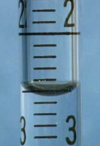Significant figures and conversion factors Flashcards
Define accuracy.
How close a measurement is to a true value. Accuracy can only be determined if there is an accepted true value against which to compare.
Define precision.
How repeatable a series of measurements are. At one level, therefore, precision requires a set of data of identical measurements. Precision, however, is also estimated from signifcant figures - which give an indication of a probable precision in the event that the measurement is repeated.
Define significant figure.
All certain digits plus one estimated digit. “Certain”, in this context, means whether a second measurement would give an identical measurement. This level of “certainty” is directly tied to the precision of the equipment (e.g. graduated cylinder vs pipette) used to make the measurement.
Examine the following burette and record to the correct number of significant figures.

The best estimate for this burette measurement is 2.38 or 2.39 mL.
Examine the following graduated cylinder and record to the correct number of significant figures.

The best estimate for this graduate cylinder measurement is 76.3 or 76.4 mL.
Examine the following graduated (Mohr) pipette and record to the correct number of significant figures.

The best estimate for this pipette measurement is 2.53 or 2.54 mL.
Examine the following graduated cylinder and record to the correct number of significant figures.

The best estimate for this graduate cylinder measurement is 21.6 or 21.7 mL.
Indicate the correct number of significant figures in the following number: 1245.0
1245.0 has five significant figures. The zero after the decimal place is the “estimated” digit.
Indicate the correct number of significant figures in the following number: 1024.0
1024.0 has five significant figures. The zero after the decimal place is the “estimated” digit. The zero “trapped” between the 1 and the 2 is a certain value and is part of the measurement.
Indicate the correct number of significant figures in the following number: 12450
12450 has four significant figures. The last “tailing” zero is not considered significant. This zero in a sense indicates how large the number is. Using scientific notation, one would write 1.245x104.
Indicate the correct number of significant figures in the following number: 1.2450
1.2450 has five signifcant figures. The last zero is the “estimated” digit.
Indicate the correct number of significant figures in the following number: 0.001240
0.00124 has three significant figures. The zeros before the “1” indicates how small the number is. Using scientific notation one could write 1.24x10-3.
Indicate the correct number of significant figures in the following number: 0.01245
0.01245 has four significant figures. The zeros before the “1” indicates how small the number is. Using scientific notation one could write 1.245x10-3.
Indicate the correct number of significant figures in the following number: 1.245x10-3
1.245x10-3 has four significant figures.
In adding one number to another, what will determine the number of significant figures in the final answer?
In addition, signifcant figures are determined by looking at the least number of digits past the decimal place.
In subtracting one number from another, what will determine the number of significant figures in the final answer?
In subtraction, signifcant figures are determined by looking at the least number of digits past the decimal place.
In multiplying one number with another, what will determine the number of significant figures in the final answer?
In multiplication, significant figures are determined by looking at the number with the least number of significant figures.
In dividing one number with another, what will determine the number of significant figures in the final answer?
In subtraction, significant figures are determined by looking at the number with the least number of significant figures.
What conversion factor is required to convert mass in grams (g) to mass in kilograms (kg)?
To convert mass in grams (g) to mass in kilograms (kg) one needs to multiply by 1 kg/1000g.
What conversion factor is required to convert mass in milligrams (mg) to mass in kilograms (kg)?
To convert mass in milligrams (mg) to mass in kilograms (kg) one needs to multiply by 1 kg/1x106 mg.
What conversion factor is required to convert mass in kilograms (kg) to mass in grams (g)?
To convert mass in kilograms (kg) to mass in grams (g) one needs to multiply by 1000 g/1 kg.
What conversion factor is required to convert mass in kilograms (kg) to mass in milligrams (mg)?
To convert mass in kilograms (kg) to mass in milligrams (mg) one needs to multiply by 1x106 mg/1 kg.
What conversion factor is required to convert volume in milliliters (mL) to volume in litres (L)?
To convert volume in milliliters (mL) to volume in liters (L) one needs to multiple by 1 L/1000 mL.
What conversion factor is required to convert volume in milliliters (mL) to volume in centilitres (cL)?
To convert volume in milliliters (mL) to volume in centiliters (cL) one needs to multiple by 1 cL/ 10 mL.


